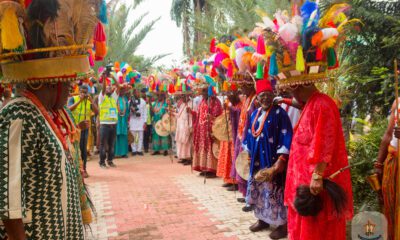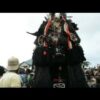Igbo Cultural Practices
The History and Meaning of Ichi Facial Marks in Igbo Society
Ichi facial marks are one of the age-long Igbo traditional practices. Discover the history, meanings, styles, rituals, and modern legacy of Ichi scarification in Igbo society.

Ichi facial Marks – an age-long Igbo traditional practice || Nnewi City
Ichi facial marks in Igbo society are more than just traditional scars. They are powerful symbols of identity, status and spirituality. For centuries, these facial markings distinguished men who had undergone special initiations, taken on leadership roles, or earned the prestigious Nze and Ozo titles.
Originating in the Nri Kingdom and spreading to surrounding Igbo communities, Ichi facial marks represented moral authority, ritual purity and a deep connection to cultural heritage.
In this article, we explore the history, meaning, styles and legacy of Ichi facial marks, revealing why they remain an enduring symbol of Igbo tradition and pride.
What are Ichi Facial Marks?
Ichi facial marks are traditional ritual scars worn mostly by men in parts of Igbo society, especially in the Nri region. These marks were not decorative, they announced that a man had undergone a formal initiation into the aristocratic Nze na Ozo title society, granting him social prestige and spiritual authority.
The scars are carved into the skin using a sharp blade, creating deep, deliberate grooves rather than raised scars. Ichi facial marks often follow specific, repeating patterns. In the Nri style, straight lines run from the forehead to the chin and across the cheeks, forming a sun‑ray design. In another style called the Agbaja style, the marks include circles or semi-circles, symbolically linked to the moon.
Beyond marking social rank, Ichi scars carried deeper meanings. They were a visible symbol of ritual purity, moral standing and a person’s right to perform cleansing rituals. In some historical accounts, men with Ichi were considered less vulnerable to enslavement because their markings identified them as belonging to a respected and spiritually significant class.
Simply put, Ichi facial marks were a deeply symbolic and highly respected tradition in Igbo culture. More than aesthetics, they connected individuals to spiritual power, social hierarchy and community identity.
Where Did Ichi Originate?
Ichi facial marks trace their origins to the Nri Kingdom, a deeply spiritual centre located in what is now Anambra State. Nri people played a critical role in shaping early Igbo ritual and social life.
According to Nri mythology, the scarification tradition began with Nri, the son of the legendary figure Eri. In one foundational story, Nri was instructed by the high god, Chukwu to mark his first son and daughter with Ichi on their foreheads before sacrificing and planting them.
From their planted heads sprang the staples of Igbo life – yam from his son, and cocoyam from his daughter. This is a myth that tied the ritual marks to fertility, earth connection and cultural identity.
Historically, Ichi was most common among men in Awka–Nri area, though a few women in nearby regions like Awgu and Nkanu also had the marks. The Nri style of Ichi which is characterized by straight lines that mimic sun rays reflects the symbolic importance of the sun in Nri cosmology.
Over time, the practice also spread to towns beyond Nri. For instance, Umudioka communities became well-known as specialist ichi practitioners, performing scarification for people in distant Igbo towns.
Some older research even connects the origins of Ichi to broader migration narratives. Anthropologist M. D. W. Jeffreys theorized that Umunri (Nri people) may have ancient links to Egypt, though this is speculative and part of larger debates about Igbo origins.
Essentially, Ichi facial marks originated in Nri, grounded in myth, ritual power and social hierarchy, and from there, it spread to other Igbo communities with strong spiritual and cultural significance.
Why Were Ichi Marks Made?

Ichi facial marks carried deep cultural and spiritual meaning in Igbo society. They were not simply decorative scars, they were powerful symbols of authority, identity and ritual purity. Rooted in both social structure and belief systems, the key reasons Ichi marks were made included:
One of the most important meanings of Ichi marks was that they indicated a man had undergone initiation into the Nze na Ozo title society, one of the most respected and sacred institutions in Igbo culture. By having these marks, the wearer was publicly recognized as noble or elite and earned the respect associated with that status.
In the traditional Igbo spiritual system, Ichi facial marks bearers were believed to have a particularly high level of ritual purity. According to historical accounts, these men could perform ikpu alu (or ikpu aru), that is, cleansing rituals for taboo or “abomination” in the land or community. This role was critical. They helped to maintain spiritual balance, restore harmony and uphold moral order in society.
The design of Ichi facial marks themselves carried cosmological symbolism. In the Nri style, the engraved lines often imitated sun rays comprising a vertical line from forehead to chin, plus horizontal lines on the cheeks, repeated to represent the sun’s radiance. In other traditions, e.g., the Agbaja style, the marks include circular or semicircular patterns thought to represent the moon. According to some sources, these patterns honoured the celestial bodies, especially the sun, and is a way to express cosmic order, light and spiritual power.
Because Ichi facial marks were strongly linked with title-taking, it also conveyed social rank, nobility and moral responsibility. Historical sources also report that men with Ichi facial marks were less likely to be enslaved. Their identity as titled and ritually clean people made them socially and spiritually special. This protection was not only symbolic, in volatile times, being visibly marked as a respected titleholder could give a practical advantage.
Beyond the ritual and social roles, Ichi facial marks also had aesthetic significance. According to anthropologist Tracie Utoh-Ezeajughi, Ichi designs enhanced the wearer’s appearance, giving a new and unique demeanour. The process of receiving Ichi was difficult and sometimes painful, so enduring it also demonstrated bravery and strength, qualities highly valued in the community.
Ichi facial marks connected a person to a broader cultural lineage and spiritual tradition. The marks tied individuals to the sacred powers of Nri, the priest‑kings, and the ancestral order. In many ways, the Ichi tradition was a way of carrying Igbo cosmology and values on the body, making spiritual and social belonging visible.
In essence, Ichi facial marks were made not just for social prestige but for spiritual authority, moral purity and cultural belonging. They marked a man as someone who belonged to the elite, could perform sacred duties and was deeply connected to Igbo cosmology.
Two Main Styles
When it comes to Ichi facial marks, there are two principal traditional styles, namely, the Nri style and the Agbaja style, each with its own design and symbolic meaning.
Nri style of ichi facial marks is the form most closely associated with the Awka–Nri area. The pattern involves a carved line that runs from the centre of the forehead down to the chin, with another line going across the face from one cheek to the other. These lines are repeated to form a radiating design, often interpreted as representing sun rays.
For the Nri people, this design was a way to honour the sun which held ritual significance, and the scarification was also considered a form of spiritual purification.
The Agbaja Style is more common in Awgu, Nkanu and related Igbo regions. In addition to the straight incisions, circles and semi-circles are added, giving the marks a moon‑like appearance.
These added circular patterns are symbolic. They are often understood to represent the moon, in contrast to the solar imagery of the Nri style. Like the Nri style, the Agbaja marks also carried deep ritual weight. For example, they were given to representatives of the Eze Nri, known as the mbùríchi.
The Initiation, Tools and Healing Process
The process of receiving Ichi facial marks was a solemn and highly ritualized affair in traditional Igbo society, not just a cosmetic act, but a deeply symbolic initiation into spiritual and social responsibility.
The scarification was usually carried out by specialist practitioners, often from Umudioka, whose role was well established in Igbo tradition. The candidate, called Nwa Ichi would lie on a mat, usually supported by a wooden pillow while the scarifier, sometimes called, the Nwadioka made the incisions.
During the procedure, the Nwa Ichi was restrained. Another assistant, called the Nwa Mgbado Ichi would hold his legs to keep him steady.
Because the operation could be very painful, the candidate’s wife or mother would offer comfort by feeding him dry fish while others sang traditional songs to encourage him. The poetic or traditional songs sung during the procedure often praised the craftsmanship of the scarifier and the spiritual importance of Ichi.
Rules governed the initiation. According to some accounts, the candidate must not move during the procedure as showing signs of pain was considered shameful.
The scarification was done using a sharp blade. Ethnographic sources mention a triangular-shaped razor referred to in older texts as a ugelle or uche. After incising the skin, some practitioners inserted a small pellet, i.e. compressed cotton wool or palm leaf underneath the cut, to encourage a raised, deeper scar.
Charcoal played a key role in after‑care. Once inserted material was in place, practitioners smeared charcoal into the wounds. Over the following days, this charcoal treatment was repeated on successive days.
According to research, the scarifier travelled with a tool bag. His assistant carried it and prepared a mat and pillow for the candidate’s head, ensuring the scarification was done carefully.
After the scarring was done, a “nurse”, called Nwa Nso would take care of the wounds for about 14 days. This person cleaned the cuts with warm water and applied herbal treatments to help healing. The charcoal application helped prevent infection and deepened the scar. During the healing period, the initiate was often secluded, or confined to allow proper recovery. According to some sources, this seclusion also allowed for spiritual reflection, ritual sacrifices or other initiation rites.
Once healing was complete, the community typically held a celebration to welcome the new title-holder: there would be feasting, singing, and formal recognition.
In some communities, like Neni, the traditional cutting has largely stopped. Since 1978, the Ichi ritual has been reinvented in symbolic form during the Nka Dioka Cultural Festival. Rather than making real cuts, the scarifier traces the Ichi pattern gently on the skin, leaving no permanent scar.
Even in this symbolic version, many traditional elements remain. The candidate lies on a mat, is comforted with fish, and songs are sung.
Who Received Ichi Marks
Ichi facial marks
Ichi facial marks were not given to just anyone, they were predominantly reserved for a select group of people in Igbo society whose status, role or lineage made the scarification deeply meaningful.
The main recipients of Ichi facial marks were men being initiated into the Nze na Ozo title society, one of the highest and most respected institutions in Igbo culture. Having Ichi was often a prerequisite for becoming a full Ozo title-holder. These titles carried both spiritual and social weight. Nze na Ozo members were seen as moral leaders, adjudicators and custodians of tradition.
Many Ichi-bearers performed ritual functions. According to historical sources, they could perform cleansing rites (ikpu alu) for abominations in the community. In the Kingdom of Nri, men marked with Ichi were acknowledged as sacred people who possessed ritual-political power.
Ichi facial marks signaled nobility. In effect, they provided a visual marker that distinguished titled men from ordinary people. The marks were also tied to class stratification as only those who could afford the scarification (its cost and the skills of practitioners) would get them. Because of the cost and expertise involved, getting Ichi was itself a demonstration of wealth or prestige.
A specialized group of scarifiers came from Umudioka in Neni and other towns, known across Igboland for their expertise in Ichi scarification. These Umudioka Ichi-practitioners would travel to other towns to perform the ritual, making Ichi facial marks widespread but still controlled by a particular lineage or craft community. While mostly men bore Ichi scars, sources report that some women, especially priestesses, also received them in specific places.
Ichi marks provided a form of social protection. In times when kidnapping and enslavement were real risks, being visibly marked with Ichi identified someone as a member of the title society and made them special and less likely to be enslaved. They offered a clear, embeddable identity. Title-holders and Ichi-bearers carried their status on their faces. The word “Ichie” used in modern Igbo to mean a titled elder or chief is believed to derive from the Ichi tradition, showing how deeply tied the scarification was to social leadership and prestige.
Some Ichi marks were inherited in a sense. Children born into families already in the Nze na Ozo class or Ichie families, sometimes received the marks, making it part of their lineage identity. Because of this, Ichi helped reinforce intergenerational status among title-holding families.
Ichi facial marks had social significance in that they made a person’s elite or ritual role visible, not just through behaviour, but literally on their face.
Another social significance of Ichi facial marks is about legitimacy and authority. A man with Ichi had the ritual and moral legitimacy to lead, mediate and enforce social norms. The marks also offered practical identity protection in a time when social status could mean safety or risk. Through Ichi, lineages, titles and traditions were passed down and made visible, linking individuals to their ancestral and spiritual heritage.
How Ichi Connected to Wider Igbo Title Systems
The tradition of Ichi facial marks was deeply intertwined with the Nze na Ozo title system, one of the most important social, spiritual, and political institutions in Igbo society. Ichi scarification often functioned as an initial initiation into the Nze–Ozo hierarchy. According to historical and ethnographic sources, receiving Ichi was commonly required before one could become a full Ozo title-holder.
In many communities, only men who already held Ichi marks were eligible to take the Ozo title. This makes Ichi not just a physical symbol, but a gateway into the elite class of traditional Igbo society, marking the transition from ordinary man to titled elder.
Members of the Nze na Ozo society were often seen as moral leaders, spiritual custodians and adjudicators. Because Ichi bearers had undergone a sacred ritual, they carried spiritual legitimacy. In some areas, they could perform cleansing rites and other religious‑legal functions. In the Nri cosmology, Ichi marks also connected the bearer to ancestral power and to the sacred authority of the Eze Nri.
Ichi facial marks served as visible proof of one’s place in the titled aristocracy. Anthropologist‑ethnographer Chuka Odike explains that men with Ichi marks often held high social status and were regarded as nobles in their communities. Holding both Ichi and an Ozo title, or being on that path gave individuals strong social legitimacy. These men had the right to invest titles on others and were accorded high respect.
The modern Igbo word Ichie used to refer to a titled elder or chief is believed to originate from Ichi, highlighting how the scarification tradition fused into the language of leadership.
The specialized skill of carving Ichi marks was traditionally monopolized by certain groups, notably the Ichi‑makers from Umudioka. These expert scarifiers travelled to perform Ichi for title aspirants, making Ichi and Ozo connection both institutional and practical. The craft of scarification reinforced the social infrastructure of the title system.
This craft‑lineage tie also meant that Ichi and Ozo were not just personal achievements, they formed part of intergenerational status for families deeply rooted in Igbo title traditions.
Although traditional Ichi scarification declined under colonialism and Christianity, the symbolic role of Ichi in the Ozo institution persists. In some communities, Ichi initiation has been adapted. Rather than real scarification, symbolic rituals are performed, but the social meaning which is entry into titled status remains.
Research into the Ọzọ initiation rites e.g., in Igbo-Ukwu shows a reconstructed restoration of traditional practices. Some elements remain spiritual and linked to ancestral identity, even if adapted to fit modern religious sensibilities.
Overall, Ichi facial marks weren’t just personal adornment, they formed a crucial bridge into the Nze na Ozo title system. Through Ichi, men gained spiritual authority, social legitimacy and entry into a respected class of Igbo elders. Even today, the legacy of that connection endures in how traditional titles and cultural memory continue to shape Igbo identities.
Why The Practice Changed or Faded
The spread of Christianity in Igboland was a major factor in the decline of Ichi scarification. Missionaries strongly opposed the practice, labelling it “pagan” or “fetish.” According to historical accounts, by the mid‑20th century, many converts abandoned scarification as part of their new Christian beliefs.
In some communities, such as Adazi Nnukwu, the traditional Ichi ritual was replaced by symbolic markers. Instead of actual facial cuts, new initiates receive a red cap and a hand fan, a change introduced under Christian influence.
Education, Western medicine and modern ideas about hygiene contributed to the fading of Ichi. Many people came to view the practice as risky as breaking the skin posed dangers of infection. Traditional scarification tools and techniques were sometimes crude or viewed as unsanitary, which made the practice less acceptable in a world increasingly shaped by biomedical ideas.
As Igbo youth embraced Western dress, education and ways of life, the social prestige associated with visible traditional marks declined. During the colonial period, European administrators and missionaries documented Ichi scarification extensively, even as they worked to suppress it. Colonial power structures, combined with Christian missionary efforts undermined traditional institutions like the Ichi‑marking ritual. Over time, the practice lost institutional support, and fewer new initiates went through the ritual.
In some Igbo communities, notably Neni, the Ichi tradition has been reinvented. Since 1978, it is practiced symbolically during the Nka Dioka Cultural Festival, rather than through actual cutting. At this modern festival, participants are marked by having the Ichi pattern traced on their skin, but no permanent cuts are made. This revival reflects both respect for tradition and adaptation to new health, moral and social norms. The last known old‑style Ichi bearer in Neni, Chief Odidika Chidolue, is honoured in cultural work and receives community support to preserve the memory of the original practice.
As Igbo society modernized, the symbolic value of Ichi shifted. Many began to regard the physical scars as less necessary for identity or respect, especially as new forms of status and leadership emerged. Some communities maintained title-taking rituals but made the Ichi part of a purely symbolic or ceremonial process, encouraging respect for heritage without the risks of scarification. Cultural memory, rather than physical marking, now carries much of the meaning of Ichi in many Igbo communities.
In summary, the decline of Ichi facial marks in Igbo society was driven by Christian missionary influence, colonial pressures, health concerns and changing modern values. But important communities have preserved the tradition through symbolic adaptations, keeping its cultural spirit alive, even without the original practice.
Modern Perception and Cultural Legacy
Even though the practice of Ichi facial marks has declined dramatically, its cultural legacy remains alive and continues to shape how many Igbo people view their history, identity and traditions.
To many Igbo today, Ichi facial marks are not just physical relics, they are powerful symbols of Igbo heritage and nobility. During cultural festivals and public celebrations, Ichi is celebrated as part of a proud tradition.
In scholarly and cultural discussions, Ichi is often linked to ideas of spiritual leadership, moral responsibility, and ancestral connection. The modern Igbo word Ichie, meaning a titled elder or chief, directly echoes the Ichi tradition, showing how the scarification practice lives on in language and status.
In Neni (Umudioka), the Nka Dioka Cultural Festival has reinvented the Ichi ritual in a safe, symbolic way. Instead of cutting the skin, a ceremonial marking is done by gently tracing the Ichi pattern on the face preserving the meaning of the tradition while avoiding scarification.
During these modern rituals, traditional Ichi songs are sung, the candidate is carried ceremonially, and symbolic tools, like the Ichi knife are used, even though no real cuts are made. This revival is part of a broader cultural effort to honour Igbo traditions in a way that fits with contemporary values, health concerns and ethical norms.
Some of the last remaining people with actual Ichi facial marks are now treated as living heritage bearers. For instance, in Neni, Chief Odidika Chidolue, one of the few surviving men with real Ichi facial marks is honoured by his community as a cultural icon. His role is more than symbolic as he helps to pass down traditional songs, stories and rituals related to Ichi. Supporting him and other culture-bearers is part of a local effort to document and preserve a tradition that many fear might otherwise vanish.
Ichi facial marks also live in Igbo art and scholarship. In academic and ethnographic work, Ichi is used to interpret social hierarchy, spiritual power and historical identity. For example, in Igbo-Ukwu art, anthropologist Chuka Odike highlights how Ichi motifs are reflected in sculptural forms, signalling that the scarification tradition had deep resonance with themes of status, beauty and ancestral power. In modern Igbo society, Ichi remains a touchstone for conversations about pre-colonial social order, the value of titles and the preservation of traditional practices.
While many communities no longer practice facial scarification due to health, ethical and religious concerns, they continue to honour the symbolism of Ichi in ways that align with contemporary life. The shift from physical marking to symbolic initiation is an example of how Igbo culture adapts by keeping the meaning alive, even if the method has changed.
For many, Ichi is no longer just a scar, it is a cultural memory, a story of resilience, and a way to connect modern Igbo identity with ancestral traditions.
In Conclusion …
More than just lines etched into the skin, Ichi facial marks are a profound symbol of identity, spirituality and social status in Igbo society. From their origins in Nri and Agbaja, through the intricate initiation rituals, to their connection with the prestigious Nze na Ozo title system, Ichi facial marks represented the intersection of culture, morality and power.
While the practice has declined due to Christian missionary influence, colonial pressures, modernization and health concerns, its cultural imprint remains vivid. Today, symbolic adaptations in festivals like the Nka Dioka Cultural Festival preserve the heritage while living Ichi bearers and historical documentation ensure that the meaning of these marks is not forgotten.
Ultimately, Ichi facial marks serve as a bridge between ancestral traditions and modern Igbo identity. They remind us of a time when personal honour, spiritual responsibility and social recognition were inseparable, and they continue to inspire cultural pride, scholarship and artistic expression.
By understanding Ichi, we gain a deeper appreciation for Igbo history, social structures and the ways in which communities creatively adapt traditions to maintain their relevance in a changing world.
References
- https://en.wikipedia.org/wiki/Ichi_%28scarification%29
- https://commons.wikimedia.org/wiki/File%3AIgbo_ichi_marks.jpg
- https://en.wikipedia.org/wiki/Nze_na_Ozo
- https://re-entanglements.net/ichi-scarification/
- https://igbostudies.unn.edu.ng/wp-content/uploads/sites/56/2025/09/12-Taking-the-Ozo-Title-in-Igbo-Cultural-Area-Anthonia-Odinakachukwu-Odezulu.pdf
You might want to check this out …






















